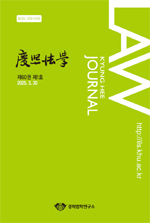- 영문명
- Revision of the crime of Taking Photographs or Videos by Using Cameras or other mechanism : Focusing on the gaps in the Supreme Court's interpretation of the rule
- 발행기관
- 경희법학연구소
- 저자명
- 이승준(Seung-jun Lee)
- 간행물 정보
- 『경희법학』제60권 제1호, 136~167쪽, 전체 32쪽
- 주제분류
- 법학 > 민법
- 파일형태
- 발행일자
- 2025.03.31

국문 초록
2010년 법 제정 이후 성폭력범죄의 처벌 등에 관한 특례법은 31번 개정되었다. 카메라등이용촬영죄도 이 같은 잦은 개정의 예외가 아니었다. 그런데 대법원은 종래 카메라등이용촬영죄의 성부 판단에 있어 ‘사람의 신체’를 엄격하게 판단해 왔다. 카메라등이용촬영죄에 있어 ‘타인의 신체’, ‘사람의 신체’를 매우 제한적으로 해석하는 대법원의 해석론은 죄형법정주의와 문리해석의 원칙에 비추어 타당하다고 생각된다. 합목적성이 결여되고 문언에만 집착한 것이 아니라 법치국가적 침해의 한계와 죄형법정원칙의 사회형성적 기능에 대한 형량의 결과라고 볼 수 있기 때문이다. ‘해석’은 ‘법문언의 가능한 의미’를 넘어 당해 사안에서 바로 적용되어야 할 법규정이 존재하지 않는 상황에서 해당 사안에 대한 법형성적 법적 결정이 되어서는 안 된다.
문제는 대법원의 해석을 통한 형법의 단편적 성격의 현실화로 인해 현실적인 규율의 공백이 발생한다는 점이다. 필자는 이에 대해 대법원 판례를 기준으로 세 부류의 사례 군을 제시하였다. 그리고 이러한 영역은 비록 구체적인 실행행위가 다를 수는 있어도 기존에 처벌되는 불법촬영 내지 촬영물을 이용한 협박(강요)행위와 불법의 측면에서 본질적 차이가 존재하지 않음을 분석하였다.
그 결과 현행 성폭력처벌법의 개정이 필요함을 검토하였다. 카메라등이용촬영죄는 여전히, 언제나 개정 중이다. 이는 아마도 디지털 성범죄라는 속성상 새로운 과학기술이 등장함에 따라 끊임없이 개정되어야 하는 숙명일 수도 있다. 최근에도 성폭력처벌법의 개정이 있었지만, 카메라등이용촬영죄 등의 감소를 위한, 보다 본질적인 개정은 첫째 현재의 성적 수치심이라는 판단 기준을 수정하고, 둘째 포섭되지 못하는 사례 군을 포섭할 수 있도록 규율 대상을 확대하며, 셋째 촬영물 등에 대한 필요적 몰수 선고를 통해 삭제가 이뤄질 수 있도록 명시하는 것이라는 점을 피력하였다.
영문 초록
Since the enactment of the Act in 2010, the The ACT ON SPECIAL CASES CONCERNING THE PUNISHMENT OF SEXUAL CRIMES has been amended 31 times. The crime of filming using cameras was not an exception to such frequent revisions. However the Supreme Court has strictly interpreted ‘the human body’ when determining the guilt of the crime of ‘the body of a person’ in the context of Taking Photographs or Videos by Using Cameras or other mechanism.
The Supreme Court's interpretive approach, which limits the understanding of ‘the body of others’ and ‘the body of a person’is considered valid in light of the principles of criminal justice and textual interpretation. This interpretation is not a result of a lack of purpose or an overemphasis on the text alone, but rather reflects the court's focus on the boundaries of legal infringement within the framework of rule of law and the social function of criminal law. Interpretation should not be a legal legislation made in the absence of clear regulations.
The issue, however, is that the fragmentary nature of criminal law leads to gaps in real-world application. In this regard, I have outlined three categories of case types. It was also analyzed that there is no significant difference between these cases in terms of Taking Photographs or Videos by Using Cameras and Intimidation or Compulsion by Using Photograph—offenses that have already been penalized—despite differences in specific behaviors.
As a result, it was concluded that the current ACT needs revision. The crime of photographing using cameras remains subject to ongoing revision, and this may continue to be the case as new technologies emerge, given the nature of digital sexual crimes. Although the ACT has been revised in recent years, a more substantive revision is necessary to reduce digital sexual crimes. This revision should first address the criteria for determining sexual shame, second, expand the scope to include case types currently excluded, and third, clarify sentencing guidelines and the confiscation or destruction of photographic evidence.
목차
Ⅰ. 문제의 제기
Ⅱ. 대법원의 해석론에 따른 문제점
Ⅲ. 입법 개선
Ⅳ. 결 론
키워드
카메라등이용촬영죄
성폭력처벌법 개정
판단 기준의 수정
대상의 확대
불법촬영물의 필요적 몰수
taking Photographs or Videos by Using Cameras or other mechanism
revision of The ACT ON SPECIAL CASES CONCERNING THE PUNISHMENT OF SEXUAL CRIMES
modifying the standard of proof
expanding the scope
requiring the necessary seizure of illegal Photograph taken by Using Cameras or other mechanism
해당간행물 수록 논문
참고문헌
최근 이용한 논문
교보eBook 첫 방문을 환영 합니다!

신규가입 혜택 지급이 완료 되었습니다.
바로 사용 가능한 교보e캐시 1,000원 (유효기간 7일)
지금 바로 교보eBook의 다양한 콘텐츠를 이용해 보세요!


